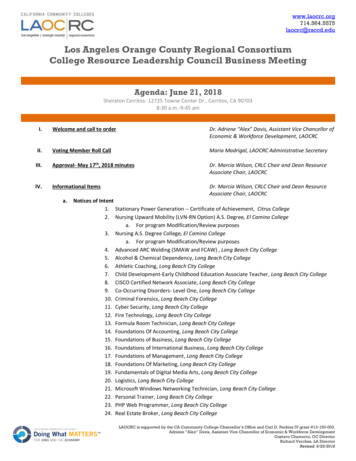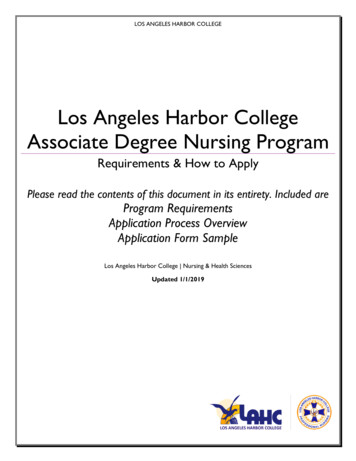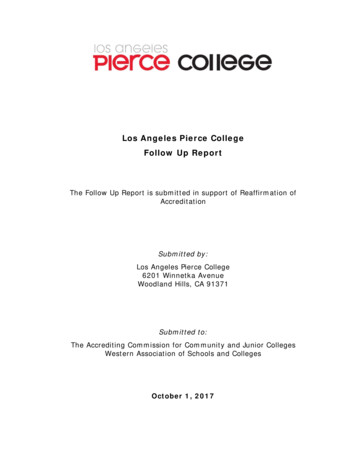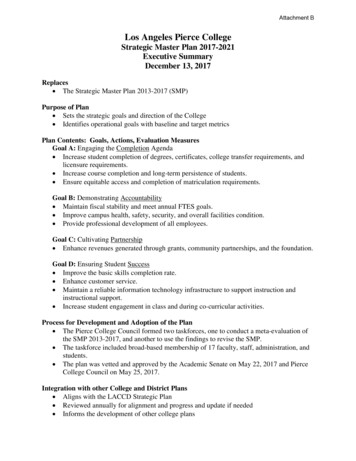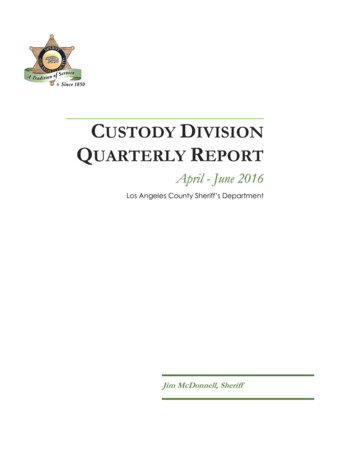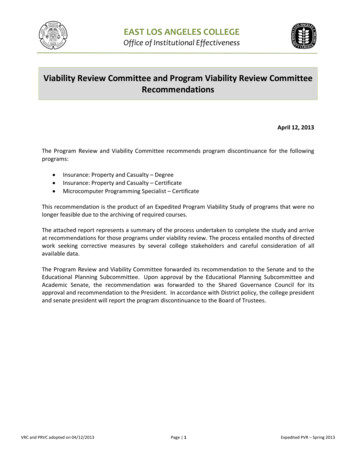
Transcription
EAST LOS ANGELES COLLEGEOffice of Institutional EffectivenessViability Review Committee and Program Viability Review CommitteeRecommendationsApril 12, 2013The Program Review and Viability Committee recommends program discontinuance for the followingprograms:···Insurance: Property and Casualty – DegreeInsurance: Property and Casualty – CertificateMicrocomputer Programming Specialist – CertificateThis recommendation is the product of an Expedited Program Viability Study of programs that were nolonger feasible due to the archiving of required courses.The attached report represents a summary of the process undertaken to complete the study and arriveat recommendations for those programs under viability review. The process entailed months of directedwork seeking corrective measures by several college stakeholders and careful consideration of allavailable data.The Program Review and Viability Committee forwarded its recommendation to the Senate and to theEducational Planning Subcommittee. Upon approval by the Educational Planning Subcommittee andAcademic Senate, the recommendation was forwarded to the Shared Governance Council for itsapproval and recommendation to the President. In accordance with District policy, the college presidentand senate president will report the program discontinuance to the Board of Trustees.VRC and PRVC adopted on 04/12/2013Page 1Expedited PVR – Spring 2013
EXPEDITED PROGRAM VIABILITY REPORTThe college is dedicated to maintaining the highest quality educational programming that is current,addresses the needs of the community and meets the College Mission. To ensure the continued viabilityof college programs, curriculum must be updated at least once every six years. To deal with instanceswhere the feasibility of offering a program has been compromised and the requirements of EducationCode section 78016, and Board Rules 6801 and 6802 are not met, the Program Review and ViabilityCommittee (PRVC) has established a process for expedited program viability that results indiscontinuance should the department fail to update course curriculum needed to complete a collegeprogram.When a program’s feasibility is directly impacted by the archival of required courses, the CollegePresident, a College Vice President, or the Academic Senate President on behalf of the Academic Senatecan initiate an Expedited Program Viability Review with a formal written request to the Program Reviewand Viability Committee (PRVC). The PRVC weighs the lack/loss of program feasibility and if the requestis approved, the default outcome for the program is discontinuance (Appendix A‐ Expedited ViabilityPolicy).Expedited Program Viability ReviewAt the December 11, 2012, PRVC meeting the Academic Senate President submitted a written request toinitiate Expedited Program Viability Review for all programs that archived courses needed for programcompletion. A Viability Review Committee (VRC) was formed to review relevant data and to work withdepartments to support work on any corrective actions.On March 01, 2013, the VRC met for the first time to review the Expedited Program Viability Reviewrequest and to develop a Preliminary Notice of Program Discontinuance Pending Response. The VRCdrafted a notice of program discontinuance to Department Chairs in charge of the jeopardizedprograms, along with a public notice of program discontinuance. Upon electronic approval of the finalversions, the notice of program discontinuance was sent to the relevant Department Chairs and thepublic notice of program discontinuance was posted on the college website.On March 27, 2013, the VRC met for the second time to review all available data. At that meeting it wasdetermined that program viability concerns remained for three programs. After carefully considering thedata presented before the VRC, which includes responses to the Preliminary Notice of ProgramDiscontinuance, curriculum sheets, and in‐depth discussions regarding impacted programs, thecommittee recommended program discontinuance for the following programs:···Page 2Insurance: Property and Casualty – DegreeInsurance: Property and Casualty – CertificateMicrocomputer Programming Specialist – Certificate
Impact on the College Mission, Strategic Master Plan, Students, Faculty and StaffASSOCIATE IN ARTS DEGREE – Insurance: Property and CasualtyCourseCourse NameUnitsACCTG 001 Introduction to Accounting I5BUS 001Introduction to Business3CAOT 032 Business Communications3CO SCI 201 Introduction to Computers and Their Uses3CO SCI 291 Programming Laboratory1INSUR 100 Introduction to Insurance1INSUR 101 Principles of Property and Liability Insurance3INSUR 102 Personal Insurance3INSUR 103 Commercial Insurance3INSUR 104 Insurance Code and Ethics1INSUR 185 Directed Study – Insurance1LAW 001Business Law I3GENERAL EDUCATION REQUIREMENTS PLAN A30Total .60Table 1: Required Courses for AA Degree in Insurance: Property and CasualtyTable 1 lists the courses needed for completion of the Associate in Arts Degree program, Insurance:Property and Casualty. An analysis of student enrollment in those courses revealed that INSUR 100,INSUR 103, INSUR 104, and INSUR 185 had never been offered at ELAC; INSUR 101 was last offeredduring the Fall 2009 term and INSUR 102 was last offered in Spring 2010. Table 2 shows enrollment, byacademic year, in the required courses for the AA Degree in Insurance: Property and Casualty since theSummer 2007 term.Course2007‐2008 2008‐2009 2009‐2010 2010‐2011 2011‐2012 2012‐2013* TotalACCTG 0019491,1531,1321,1071,232728 6,301BUS 001433517587609617292 3,055CAOT 0326578103106121473CO SCI 2011,5331,5781,4931,3451,530561 8,040CO SCI 2911,5651,6101,5621,3681,580586 8,271INSUR 1012727INSUR 1021313LAW 001645766796953994581 4,735Total5,1905,7025,7135,4886,0742,748 30,915Table 2: Enrollment by Academic Year; *Figures for the current academic year are not finalThe committee determined that discontinuance of the Insurance: Property and Casualty AA Degreeprogram will have minimal impact on the College and its stakeholders. In consultation with the college’sArticulation Officer, the committee learned that the archived courses listed in Table 1 are not UC:CSUtransferable; an analysis of program completers yielded a total of 0. Faculty, students, and staff will notbe affected because a number of required courses were never offered and no curricular/programmaticchanges are needed. Likewise, there will be no economic impact on the community because theprogram never had an effect on the community. Finally, the effect on the budget‐planning process isundetermined as of the writing of this report because the department associated with the discontinuedprogram has not provided ample evidence.Page 3
CERTIFICATE OF ACHIEVEMENT – Insurance: Property and CasualtyRequirements for the completion of a Certificate of Achievement in Insurance: Property and Casualtyare similar to the requirements for completion of the AA Degree in Insurance: Property and Casualty.The major difference is that students completing the Certificate of Achievement are not required tocomplete 30 units of general education (see Table 1). Consequently, as is the case with the AA Degree inInsurance: Property and Casualty, discontinuance of the Certificate of Achievement in Insurance:Property and Casualty will have minimal impact on the College and its stakeholders.CERTIFICATE OF ACHIEVEMENT – Microcomputer Programming SpecialistIn consultation with the Department Chair of Business Administration, the Curriculum Chair learned thatthere are curricular and programmatic redundancies between the Certificate of Achievement –Microcomputer Programming Specialist program and Computer Science Information Technology –Programming and Computer Science Information Technology – Microcomputers. An analysis of programcompleters revealed that 4 students have completed the Microcomputer Programming Specialist sinceits initial offering in Summer 2009.Tables 3 and 4 below show the required courses for completion of the program and enrollment trends inthe required courses since Summer 2007, respectively. A review of the data promptly reveals lowenrollment in some of the required courses, particularly in CO SCI 233 and CO SCI 239. Additionally, COSCI 239 was last offered in Spring 2009. The feasibility of completing the Certificate of Achievement inMicrocomputer Programming Specialist remains problematic because two of the required coursesremain archived (see Table 5).CourseCO SCI 200CO SCI 201CO SCI 208CO SCI 233CO SCI 239CO SCI 291Course NameUnitsMicrocomputers in Business3Introduction to Computers and Their Uses3Beginning BASIC Programming3Microcomputer Database Programming3Beginning Programming in C3Programming Laboratory1Total .16Table 3: Required Courses for Certificate of Achievement in MicrocomputerProgramming SpecialistCourse2007‐2008 2008‐2009 2009‐2010 2010‐2011 2011‐2012 2012‐2013* TotalCO SCI 20011418116714613750795CO SCI 2011,5331,5781,4931,3451,5305618,040CO SCI 2089612582748069526CO SCI 233164033233216160CO SCI 239352964CO SCI 33,3372,9563,3591,282 17,856Table 4: Enrollment by Academic Year; Courses in Italics Remain Archived; *Figures for the current academic year arenot finalThe small number of program completers, lack of required course offerings and curricular andprogrammatic redundancies discovered during the investigation, guided the committee’srecommendation to discontinue the AA Degree in Insurance: Property and Casualty, Certificate ofAchievement in Insurance: Property and Casualty, and the Certificate of Achievement in MicrocomputerProgramming Specialist.Page 4
APPENDIX – AExpedited Program Viability Review Policy forPrograms No Longer Feasible Due to Archivingof Required Course(s)Page 5
EAST LOS ANGELES COLLEGEOffice of Institutional EffectivenessExpedited Program Viability Review:Programs No Longer Feasible Due to Archiving of Required Course(s)Program Viability Review is a process through which East Los Angeles College (ELAC), in consultation with itsAcademic Senate, conducts an “in depth analysis, beyond that provided through program review” of an “educationalprogram,” as defined in Title 5, section 55000(g). Board Rule 6803, this standard for Program Viability Reviewensures that the College’s instructional resources are used in response to the College Mission, the goals andobjectives outlined in its Strategic Master Plan, the needs of the students and of the community it serves. TheProgram Viability Review considers the program’s link to the college “Mission”, a clear “need” for the program,“quality” of the program, the “feasibility” of offering the program, and “compliance” of the program with all relatedlegal and governing obligations. Program termination or discontinuance shall be considered if a program fails tomeet the requirements of Education Code section 78016, and Board Rules 6801 and 6802.In instances when a degree or certificate program is no longer feasible because a course required for that program isarchived, the program will undergo an Expedited Program Viability Review to determine what actions should betaken, such as program maintenance, modification, improvement, or discontinuance. The procedures for ExpeditedProgram Viability Review ensure it satisfies the standard for Program Review Viability.Procedure for Initiation of an Expedited Program Viability ReviewExpedited Program Viability Review can only be initiated by the College President, a College Vice President, or theAcademic Senate President on behalf of the Academic Senate. A formal request is written and brought to theProgram Review and Viability Committee (PRVC) for approval and initiation of a viability study.When a program’s feasibility is directly impacted by the archival of required courses, the lack/loss of programfeasibility will be the determining factor on whether the Program Review Viability Committee (PRVC) decides thatthe request for an Expedited Program Viability Review should be approved. In this instance, if the required courseswill no longer be offered, program discontinuance will be the default outcome.If at any time during the Expedited Program Viability Review the department/program heads take sufficientcorrective actions, the Viability Review Committee will terminate the Expedited Program Viability Review Process.After cessation of the Expedited Program Viability Review, it is still possible for the standard Program ViabilityReview to be conducted, if requested and approved under the college policy for such review.Page 6
Procedure for Establishing the Viability Review CommitteeApproval to conduct an Expedited Program Viability Review is granted by the PRVC and it is carried out by theViability Review Committee (VRC). The Office of Institutional Effectiveness facilitates appointment of VRCmembers. VRC composition shall include:A. The Program’s Supervising Vice PresidentB. 2 DeansC. 3 Academic Senate Representatives (at least 1 Chair from similar type of department – WorkforceEducation and Economic Development or Liberal Arts and Sciences)D. The Curriculum ChairE. 1 AFT RepresentativeF. 1 Classified Representative (if the department employs classified Instructional Assistants or LaboratoryTechnicians)G. 1 Office of Institutional Effectiveness FacilitatorH. At most two “outside experts” from other institutions when either program initiation or programdiscontinuance is being considered/when appropriateAlthough the VRC will solicit information from members of programs under review, the VRC itself will not includerepresentatives from programs that may be directly affected by the viability review process. The VRC will bedisbanded and discontinuance procedures terminated, if corrective measures are taken by the program’s departmentheads before the Program Viability Report is put together.Process for Conducting the Expedited Program Viability ReviewOnce the VRC is formed, the committee will meet to review the Expedited Program Viability Review process,establish a data collection plan for the study it is about to undertake, and draft and disseminate a Preliminary Noticeof Program Discontinuance Pending Response to the Department Chair, Dean and/or other program head. A noticeperiod of one month will provided for Department Chair, Dean, other program head, and interested parties toforward a response to the VRC. During the notice period, data collection period will also commence. The datacollection should include data gathering; solicitation of position papers from faculty, staff, students and supervisorsthat may be affected by the Expedited Program Viability Review; consultations with outside experts, faculty and/oradministrators from other institutions. At the start of the notice period, at least one well publicized announcement ofthe Expedited Program Viability Review should be provided to members of the campus community, via the collegewebsite or Campus News, or the College’s Service Area, and written statements about their opinions and concernsshall be welcomed. In addition, the VRC shall consult (when appropriate) with District, regional, State agencies andinstitutions overseeing specific types of programs (such as vocational programs).VRC will consider extending the notice period if the extension does not interfere with the College having sufficienttime for completion of the next two stages of the Expedited Program Viability Review, deadlines for articulationagreements, and/or catalog updates.Procedures and Rationale for Development of Program Viability ReviewRecommendationsWithin 2 months of the VRC’s formation, the committee will produce a Program Viability Report (PVR) specifyingthe outcome of its deliberations and making specific recommendations for action, complete with timelines. The PVRshall include the following:A.B.C.D.Page 7A summary of the process used by the VRCA review of all data consultedFormal committee recommendationsA detailed assessment of the recommendations’ impact on the College’s Mission, Strategic Master Plan,and budget as well as its likely impact on students, faculty, and staff
Possible outcomes of an Expedited Program Viability Review may include recommendations on the following:A.B.C.D.Program continuanceProgram modificationProgram improvementProgram discontinuanceProgram DiscontinuanceIn general, program discontinuance should be recommended only after a serious attempt has been made to improve aprogram’s effectiveness and efficiency, unless it is clear that future efforts at remediation are not warranted.Pursuant to Board Rule 6801 and 6802, a viability review is required prior to program discontinuance and, inaccordance with Board Rule 6803.10, when recommending program discontinuance, it must consider the following:A. The effects on students and student success if the program is discontinuedB. Provisions that can and should be made for students in progress to complete their trainingC. The impact that discontinuance of the program will have on the comprehensiveness and balance ofofferings across the college curriculum and within the districtD. How the program’s discontinuance would impact the educational and budget planning process used at theinstitutionE. How the program’s discontinuance affects the regionF. The effects of the program’s discontinuance on transfer to four year colleges and universitiesG. The effects of the program’s discontinuance on local business and industriesH. The effects of the program’s discontinuance on faculty and staffMaking the DecisionOnce approved by PRVC, the PVR and its accompanying recommendations, shall be forwarded to the AcademicSenate for approval. The PVR shall also be forwarded to the Educational Planning Subcommittee and the ELACShared Governance Committee (ESGC) for approval. The approved PVR is then forwarded to the College Presidentfor final approval and decision making of the VRC’s recommendations. In the case of program discontinuance, theCollege President and the Academic Senate President shall make program discontinuance recommendations to theBoard of Trustees for approval. The recommendations shall include a description of the viability review process andthe reasons for the recommendation.Expedited Program Viability Review TimelineViability ReviewCommittee (VRC)Holds InitialMeetingandDevelops &DisseminatesPreliminary Noticeof DiscontinuancePending ResponseMonthPRVC 12/12Page 8Response Period per Department Chair, Deanand/or Other Program HeadData Collection(takes into account responses including solicitationpapers and public notice responses, updates fromCurriculum and Department Chairs)1Compose ProgramViability Report(includesrecommendations fordecision making)2Making the Decision(PVR approvals fromAcademic Senate, EPSCand ESGC forwarded toCollege President for finalapproval)3ESGC adopted December 10, 2012
Insurance: Property and Casualty –Certificate . ACCTG 001 Introduction to Accounting I 5 . Program Viability Review is a process through which East Los Angeles College (ELAC), in consultation with its Academic Senate, conducts an “in depth analysis, beyond that provided through program review” of an “educational .File Size: 334KBPage Count: 8
